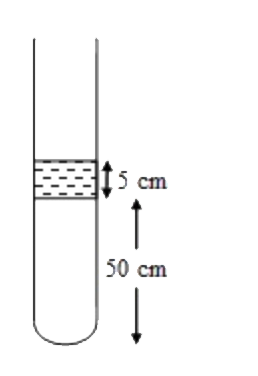Explain how is the height of mercury column in the tube of a simple barometer, a measure of the atmospheric pressure.
To explain how the height of the mercury column in the tube of a simple barometer is a measure of atmospheric pressure, we can break down the explanation into several steps:
Step 1: Understanding the Barometer
A barometer is an instrument used to measure atmospheric pressure. A simple barometer consists of a tube filled with mercury, which is inverted into a container also filled with mercury.
Step 2: Setting Up the Barometer
When the tube is inverted into the container, some mercury will flow out of the tube and into the container, creating a vacuum at the top of the tube. The mercury will settle at a certain height, which we will denote as 'h'.
Step 3: Atmospheric Pressure Acting on Mercury
The height of the mercury column is influenced by the atmospheric pressure acting on the surface of the mercury in the container. This atmospheric pressure (P_atm) pushes down on the mercury, causing it to rise in the tube.
Step 4: Applying Pascal's Law
According to Pascal's Law, the pressure at the same height in a fluid is constant. Therefore, at the same height in the mercury column (inside the tube) and at the surface of the mercury in the container, the pressures must be equal.
Step 5: Relating Height to Pressure
The pressure at the height 'h' in the tube can be expressed using the formula:
P=ρgh
where:
- P is the pressure,
- ρ is the density of mercury,
- g is the acceleration due to gravity,
- h is the height of the mercury column.
Step 6: Equating Pressures
Since the pressure at the height in the tube (due to the mercury column) must equal the atmospheric pressure, we can write:
Patm=ρgh
Step 7: Conclusion
Thus, the height of the mercury column (h) in the barometer is directly proportional to the atmospheric pressure. A standard atmospheric pressure corresponds to a height of approximately 76 cm of mercury. Therefore, by measuring the height of the mercury column, we can determine the atmospheric pressure.
---
A barometer is an instrument used to measure atmospheric pressure. A simple barometer consists of a tube filled with mercury, which is inverted into a container also filled with mercury.
When the tube is inverted into the container, some mercury will flow out of the tube and into the container, creating a vacuum at the top of the tube. The mercury will settle at a certain height, which we will denote as 'h'.
The height of the mercury column is influenced by the atmospheric pressure acting on the surface of the mercury in the container. This atmospheric pressure (P_atm) pushes down on the mercury, causing it to rise in the tube.
According to Pascal's Law, the pressure at the same height in a fluid is constant. Therefore, at the same height in the mercury column (inside the tube) and at the surface of the mercury in the container, the pressures must be equal.
The pressure at the height 'h' in the tube can be expressed using the formula:
P=ρgh
where:
- P is the pressure,
- ρ is the density of mercury,
- g is the acceleration due to gravity,
- h is the height of the mercury column.
Since the pressure at the height in the tube (due to the mercury column) must equal the atmospheric pressure, we can write:
Patm=ρgh
Thus, the height of the mercury column (h) in the barometer is directly proportional to the atmospheric pressure. A standard atmospheric pressure corresponds to a height of approximately 76 cm of mercury. Therefore, by measuring the height of the mercury column, we can determine the atmospheric pressure.
Topper's Solved these Questions
- PRESSURE IN FLUIDS AND ATMOSPHERIC PRESSUREBOOK - ICSECHAPTER - PRESSURE IN FLUIDS AND ATMOSPHERIC PRESSUREEXERCISE - Exercise -4(B)Multiple choice
3 Videos
- PRESSURE IN FLUIDS AND ATMOSPHERIC PRESSUREBOOK - ICSECHAPTER - PRESSURE IN FLUIDS AND ATMOSPHERIC PRESSUREEXERCISE - Exercise -4(B)Numericals
5 Videos
- PRESSURE IN FLUIDS AND ATMOSPHERIC PRESSUREBOOK - ICSECHAPTER - PRESSURE IN FLUIDS AND ATMOSPHERIC PRESSUREEXERCISE - Exercise-4(A)Assumptions
4 Videos
- MOTION IN ONE DIMENSION BOOK - ICSECHAPTER - MOTION IN ONE DIMENSION EXERCISE - EXERCISE -2 (C) ( Multiple choice type :)
17 Videos
- PROPAGATION OF SOUND WAVES BOOK - ICSECHAPTER - PROPAGATION OF SOUND WAVES EXERCISE - EXERCISE -8(B) (Multiple choice type)
3 Videos
Similar Questions
Why mercury is used in barometer for measuring atmospheric pressure?
View SolutionWhich instrument is used to measure atmospheric pressure ?
View SolutionThe vertical height of mercury which a simple barometer can support at sea level is:
View SolutionA barometer is constructed with its tube having radius 1.0 mm. Assume that the surface of mercury in the tube is spherical in shape. If the atmospheric pressure is equal to 76 cm of mercury, what will be the height raised in the barometer tube? The contact angle of mercury with glass135∘ and surface tension of mercury =0.466Nm−1. Density of mercury=13600kgm−3.
View SolutionThe vertical height of mercury in a simple barometer is dependant on the area of cross-section of barometer tube.
View SolutionIllustrate with the help of a lebelled diagram of a simple barometer that the atmospheric pressure at a place is 76 cm of Hg.
View SolutionA vertical tube of length 100 cm contains a mercury pallet of length 5 cm as shown in the figure. The length of the tube above mercury pallet if the tube is inverted is nearly: (atmospheric pressure = 75 cm Hg of Hg)

View SolutionExplain why does the mercury level in a barometer go down when atmospheric pressure decreases?
View SolutionThe space above the mercury in a simple barometer is called :
View SolutionMention two demerits of a simple barometer and state how they are removed in a Fortin barometer.
View Solution
